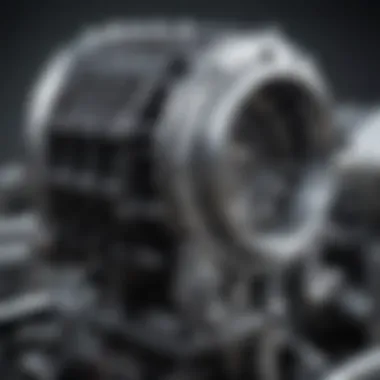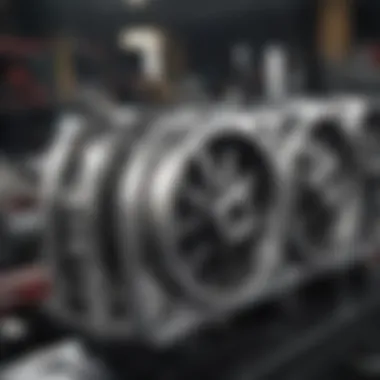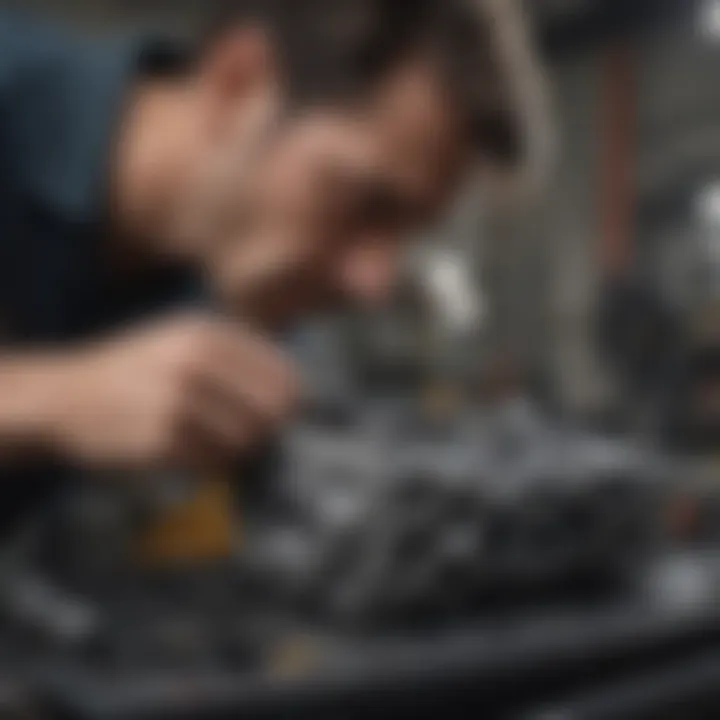Understanding Cracked Cylinder Head Sealers


Intro
The engine is often regarded as the heart of any vehicle, be it a car or a boat. However, this heart can sometimes develop cracks that may lead to serious issues, particularly a cracked cylinder head. This can spiral into a number of problems if not managed properly. Cracked cylinder head sealers have emerged as a popular solution for these woes, providing a means to temporarily address leaks and maintain engine performance.
In this article, we’ll look closely into how these sealers work. Further, we’ll consider their composition, applications, advantages, and disadvantages. Understanding how these products function is essential for both automotive enthusiasts and repair professionals aiming to safeguard their engines. The goal is to dissect the mechanics of cylinder head failure while also providing real-world examples and expert opinions to guide readers in making informed choices.
Foreword to Cracked Cylinder Heads
Understanding cracked cylinder heads is pivotal in addressing the challenges associated with engine repair and maintenance. A cylinder head serves as a crucial component of an engine, affecting everything from performance and efficiency to emissions and longevity. The importance of grasping how and why these issues occur offers valuable insights into effective prevention and repair strategies.
In this segment, we will delve into the definition and function of a cylinder head, followed by a close investigation of the common causes of cylinder head cracking. Each element will contribute to forming a complete picture about cracked cylinder heads, setting the stage for further exploration into related sealers and products designed to mitigate these issues.
Definition and Function of a Cylinder Head
A cylinder head is positioned atop the engine block and plays an essential role in the overall layout of the engine. It houses a network of components like valves, spark plugs, and fuel injectors, essentially forming the top of the combustion chamber. This design ensures that the engine can efficiently combust fuel, while also allowing exhaust gases to escape.
The cylinder head's functions are not just limited to housing these critical parts; it also serves to regulate airflow, maintain engine compression, and handle coolant flow to prevent overheating. An adequately functioning cylinder head is key to an engine that performs well and runs smoothly.
Common Causes of Cylinder Head Cracking
Several factors can lead to cylinder head cracking, which in turn can compromise engine performance. Understanding these causes is crucial for any engine enthusiast or professional seeking to maintain their vehicles effectively.
Overheating Engine
Overheating stands out as one of the most frequent culprits behind cylinder head failure. When an engine operates for extended periods at high temperatures, it can cause the metal of the head to warp or crack. High temperatures alter the structural integrity of materials, leading to a loss in strength and durability. This aspect is critical for this article since it pinpoints how heat dissipation mechanisms within an engine can fail, resulting in expensive repairs.
The characteristic that makes overheating particularly troublesome is the speed at which it can occur; a few minutes of overheated operation can lead to significant damage. Plus, this issue often signals underlying problems in the cooling system, like a malfunctioning thermostat, which means addressing one problem may lead to troubleshooting several others.
Mechanical Failure
Mechanical failures can stem from various issues, including improper installation, manufacturing defects, or simply wear and tear over time. When components linked to the cylinder head — such as bolts that secure it — fail, it can lead to significant cracks as the pressure in the combustion chamber increases without adequate restraint.
The advantageous point of understanding mechanical failure is that it can often be avoided with rigorous inspections and adherence to best practices during installation and maintenance. Not recognizing this risk can be detrimental, as it often leads to expensive repairs or even complete engine replacements.
Corrosion Effects
Corrosion poses a substantial risk to cylinder heads made of aluminum or cast iron. Elements like rust can eat away at the metal, leading to weak points that can crack under operational stresses. The article will highlight how this gradual degradation can be silent at first, making it easy for drivers to remain unaware until it's too late.
Moreover, the unique characteristic of corrosion is that it can also be remedied somewhat effectively through protective coatings or regular maintenance checks. However, neglecting these preventive measures can result in eventual failure, emphasizing the delicate balance required to maintain engine integrity.
By exploring these foundational elements, it sets the groundwork for a deeper understanding of cracked cylinder heads and the subsequent discussions about the sealers designed to alleviate some of these issues.
Preface to Cylinder Head Sealers
Understanding cylinder head sealers is crucial for any car enthusiast or professional working in the automotive repair industry. A cracked cylinder head can lead to significant engine troubles, not to mention unscheduled repairs that can wreak havoc on your budget. Cracked cylinder head sealers serve as a temporary reprieve—often at an affordable price—allowing vehicle owners to maintain their cars until they can manage a complete repair or replacement. Their role cannot be understated, as they offer a feasible solution that prevents further damage and can even buy time to properly address underlying issues.
Purpose of Cylinder Head Sealer Products
The primary purpose of cylinder head sealer products is to provide a stopgap for leaks that arise due to cracks in the cylinder head or head gasket. They act by filling the gaps and forming a seal that can withstand the pressure and temperature levels typical of engine operation. This temporary solution is, however, not just about plugging leaks; it serves several significant roles:
- Cost-Effectiveness: Replacing a cylinder head is often an extensive and costly process. Sealers offer a much cheaper and swift alternative to avoid immediate breakdowns.
- Ease of Application: Many sealers come in easy-to-use forms, like pour-in solutions, making them accessible to even amateur mechanics who may feel comfortable handling their own repairs.
- Extended Engine Life: By stopping leaks, sealers can ultimately help in prolonging the life of the engine, preserving its performance and reliability.
These sealers, however, should not be viewed as a permanent fix. They are intended for use in emergency scenarios where immediate attention isn't possible but should be paired with comprehensive repairs in the long run.


Industry Standards and Regulations
As with any product that affects vehicle performance and safety, cylinder head sealers are governed by various industry standards and regulations. These standards vary by country and can be quite rigorous.
- Certification Requirements: Many reputable sealers undergo testing to meet specific automotive standards, ensuring they can perform as promised. Checking for certifications such as ASE or complying with environmental regulations ensures that the products are safe to use.
- Manufacturer Guidelines: Always refer to the manufacturer's guidelines and recommendations for any specific sealer used. Some may be designed explicitly for certain types of engines or conditions.
- Environmental Considerations: With growing awareness about environmental impacts, some product manufacturers adhere to regulations that focus on reducing harmful chemical components, advocating for greener formulations while maintaining efficiency.
"Understanding the standards that govern cylinder head sealers is not just important for compliance; it’s essential for ensuring the longevity and performance of your engine."
In summary, cylinder head sealers play a pivotal role in the remediation of cracked cylinder heads. Knowing their purpose and the regulations that guide their development empowers users to make informed choices that could save time, money, and possibly their engines. As we move forward in this article, a deeper look into how these sealers work will provide further clarity on their efficacy and long-term reliability.
Mechanisms of Action for Sealers
Understanding the mechanisms of action for cracked cylinder head sealers is pivotal for anyone concerned about engine maintenance. This section will illuminate how these products function primarily through their chemical composition and application techniques. By examining these aspects, one gains insights into their effectiveness, potential impacts on engine health, and the importance of making informed choices.
Chemical Composition
The chemical makeup of sealers plays a foundational role in how they address cylinder head issues. A deeper look into the two prevalent categories—polymer-based and metal-based sealants—reveals their unique benefits and drawbacks.
Polymer-based Sealants
Polymer-based sealants often stand out for their flexibility and durability. Typically formulated with synthetic polymers, these sealants can adapt to the slight movements and vibrations of an engine. This characteristic renders them a popular choice among enthusiasts seeking a reliable, resilient solution for their engines.
A key advantage of polymer-based sealants is their ease of application. They generally require less extensive preparation and can be directly applied on the affected areas without requiring high levels of skill. However, one must acknowledge a notable limitation: while these sealants can effectively seal leaks, they may not provide a long-term permanent solution, especially for severe cracks. They often serve better in situations where the customer prefers a quick fix over an extensive repair.
Metal-based Sealants
Metal-based sealants, on the other hand, boast their strength and resilience. These products often mix fine metal particles into their composition, forming a tough bond when cured. This feature enhances their ability to withstand extreme temperatures and high-pressure environments found within an engine.
What makes metal-based sealants a favored option in some circles is their potential for creating a more lasting repair. However, caution is warranted. If misapplied or used on very minute cracks, these sealants can lead to excessive rigidity. This rigidity can ultimately induce further stress on the head, which might cause additional cracks in the long run. Understanding this trait helps one weigh the practicality of metal sealants against the specific needs of their engine.
Application Techniques
The successful utilization of cylinder head sealers isn’t solely dependent on their composition; the application techniques used also have significant impacts on their efficacy. Two common methods include the direct application method and pour-in solutions.
Direct Application Method
The direct application method allows for targeted sealing. Users typically begin by thoroughly cleaning the relevant area to ensure a solid bond. This technique is beneficial because it allows for precision; you can apply the sealer precisely where needed. Its straightforward nature appeals to many who prefer a hands-on approach. However, it requires adequate manual dexterity and attention to detail. Missteps during application could result in incomplete sealing, leading to further leaks down the line.
Pour-in Solutions
Conversely, pour-in solutions present a less labor-intensive alternative. Engine owners pour a liquid sealant directly into the cooling system or oil reservoir, allowing the material to circulate and fill gaps on its own. This method is particularly attractive for those who may not have the time or ability to perform a direct application. However, a critical downside to this approach is that it may not address localized issues effectively. Pour-in solutions can be seen as more of a temporary measure rather than a comprehensive repair solution.
It's essential for users to consider both the product type and the method of application when dealing with cracked cylinder heads. Ignorance in either can lead to amplified problems later on.
By dissecting both sections of this part of the article, it becomes clear that understanding the mechanisms of action for sealers is key to informed decision-making in engine maintenance. Being well-informed allows enthusiasts and professionals alike to make smart choices tailored to their specific needs.
Assessment of Cracked Cylinder Head Sealers
In tackling the challenge of cracked cylinder head sealers, a comprehensive assessment becomes crucial. These sealers are more than just temporary fixes; they can dictate the overall health and longevity of an engine. By evaluating the effectiveness of various sealers, one can make an informed choice that aligns well with both immediate needs and long-term vehicle performance.
Performance Metrics
Leak Prevention
Leak prevention stands as a cornerstone metric when assessing the efficacy of cylinder head sealers. This characteristic directly influences the engine’s operational efficiency and can significantly reduce the risk of further damage. A sealer that excels in preventing leaks can spare a car owner from costly repairs and the hassle of frequent maintenance. The unique feature here is its ability to flow into micro-cracks and form a tight bond that keeps coolant and oil contained within their respective channels. This advantage contributes not just to immediate savings but also enhances engine performance.


A popular product in this segment is BlueDevil Head Gasket Sealer, known for its robust formulation that tackles leaks effectively. Users appreciate its straightforward application process, allowing them to address problems without extensive engine disassembly. Nonetheless, it’s important to remember that while leak prevention is beneficial, reliance solely on sealers can delay more serious underlying issues from being addressed.
Temperature Resistance
Temperature resistance also holds a significant place in evaluating cracked cylinder head sealers. This aspect reflects how well a sealer can withstand the immense heat generated within an engine, particularly under heavy workload conditions. A sealer that can hold its integrity at high temperatures is vital for maintaining stable performance. The standout feature here is how some products maintain their sealing properties even when exposed to extreme fluctuations in temperature, making them suitable for both high-performance and regular vehicles.
For instance, Permatex High-Temp Red RTV Silicone Gasket Maker is well-regarded for its ability to withstand high temperatures without breaking down. Users find this feature reassuring, especially when dealing with engines that operate in varied climates. However, it is worth noting that extreme temperature resistance may come at the cost of longer curing times, which could be a consideration for those in urgent need of repairs.
Comparison of Available Products
User Reviews
When navigating through the plethora of products available, user reviews provide invaluable insight. They often serve as a litmus test of a product’s real-world performance. A sealer that garners positive reviews frequently highlights features such as ease of use, effectiveness in sealing, and durability over time. For example, many reviews for Bar's Leaks Head Gasket Repair laud its chemistry, which allows for effective sealing without professional equipment.
While user reviews present critical perspectives, they can sometimes be skewed by individual experiences that don't reflect the average performance. Thus, it's prudent to weigh these insights along with other metrics for a well-rounded view.
Manufacturer Recommendations
Manufacturer recommendations also hold weight when assessing cracked cylinder head sealers. They often come backed by research and extensive testing, guiding users toward products that align well with specific engine conditions. For instance, K&W Permanent Head Gasket Repair is often recommended for its compatibility with varying engine types and its ability to alleviate pressure in cooling systems.
These recommendations could serve as a safety net, steering users away from subpar products. Nevertheless, it’s essential to approach them with a discerning mindset, as manufacturers may have vested interests that could color their suggestions. Understanding these nuances adds depth to the strategy of selecting a reliable head sealer.
The Installation Process
A proficient installation process not only enhances the effectiveness of cracked cylinder head sealers but establishes a solid foundation for a successful repair. Equally important as the choice of sealer itself, the installation process plays a crucial role in ensuring long-term seal durability. It involves meticulous preparation, methodical application, and attention to curing times.
Preparation Steps
Engine Inspection
Carrying out an engine inspection before applying a sealer is paramount. This step allows for identifying the extent of the damage, ensuring that the right approach is taken moving forward. By pinpointing the specific crack locations, one can determine whether a sealer can adequately address the issue or if more drastic repairs are required. The key characteristic of engine inspection is its ability to prevent a haphazard application of sealers, which often leads to disappointing results.
As a beneficial choice in this article, inspection is advocated because it minimizes unnecessary costs associated with failed repairs. However, there’s a unique aspect to this step: inspectors must possess a keen eye and an understanding of engine dynamics, as overlooking minute details may have dire consequences. This meticulous inspection can save time, effort, and funds in the long run.
Cleaning Procedures
The cleaning procedures are crucial in ensuring that the surface is ready for the sealer. A thorough cleaning removes any oil, grease, or debris that could hinder adhesion and disrupt the sealing process. Its primary characteristic is that it sets the stage for optimal sealer performance. By prioritizing clean surfaces, the chances of achieving a reliable bond significantly increase, making it a valuable pre-application step. One unique feature here is that various cleaning methods may be used, such as solvent cleaning or mechanical abrasion, each with its own merits. However, in this article, the recommended practice is to use a combination of these methods to ensure comprehensive surface preparation, allowing for maximum adhesion.
Step-by-Step Application
Sealer Application
Applying the sealer requires a careful and systematic approach. The application method should align with the specific type of sealer being used—be it a pour-in variety or a more traditional paste format. The key aspect of sealer application is ensuring an even distribution over the affected area. This not only fosters a uniform bond but also minimizes potential weak spots. In discussing its importance in this article, one should highlight that proper application contributes directly to the overall effectiveness of the sealer. The unique challenge here lies in mastering the technique—too much can lead to messy overflows, while too little can leave cracks exposed. An advantageous outcome depends heavily on precision during this stage.
Recommended Curing Times
Curing times are another critical component in the installation process. They vary depending on the type of sealer used and environmental conditions. The main characteristic here is that adhering to recommended curing times solidifies the seal, allowing it to achieve its full potential. Highlighting the significance of this in the broader context of cylinder head repair lays bare the risks of rushing the process—impatience can lead to premature failure of the seal. The unique feature of curing is that it involves a chemical reaction; hence, any shortcuts can be detrimental. In this article, it's wise to emphasize a disciplined approach to curing, as this ensures the longevity and reliability of the seal, contributing positively to engine health.
Evaluating Effectiveness Post-Application
When it comes to assessing cracked cylinder head sealers, understanding the effectiveness after application is crucial for ensuring the longevity and functionality of the engine. This phase not only determines if there was a successful seal but also provides insights into how well the product holds up under operational conditions. Key elements resonate with both immediate and long-term advantages of these sealers.
Monitoring Engine Performance
Monitoring engine performance post-application is not just a matter of routine; it’s essential for identifying how well the sealer is doing its job. One of the best first steps is to keep an eye on the engine temperature. A sealed head should maintain optimal operating temperatures, showing no signs of overheating. Any fluctuations here can be an indication of unresolved issues, which may require revisiting the sealant.
Another important factor to assess is the engine’s power output. After applying a cylinder head sealer, a healthy engine should operate smoothly, with no noticeable drop in power. Significant loss in performance can indicate a failure of the sealing process or a deeper mechanical problem.


Consider the following signs when monitoring engine performance:
- Fluid Levels: Regularly check coolant and oil levels. If either seems to be depleting rapidly, there might be internal leaks.
- Engine Noise: Uneven or increased noise after sealing can signal a failure in the sealing process.
- Emissions: A sudden increase in exhaust emissions could also hint at a problematic seal.
Signs of Successful Sealing
Recognizing the signs of successful sealing can save car enthusiasts from engagement in unnecessary repairs. A well-applied cylinder head sealer should provide clear indicators of efficiency.
- Lack of Leaks: The primary sign is the absence of leaks. Checking the coolant and oil for signs of mix, via color changes or sludge, can reveal how successful the sealing was.
- Stable Temperature: Maintaining a consistent operating temperature without overheating is a strong indication that the sealer is working effectively.
- Positive Performance Changes: If, after application, the vehicle seems to gain back lost acceleration or power, this is a strong indicator that the sealant has effectively mitigated previous issues.
- Vibration Reduction: A smoother engine operation will often lead to reduced vibrations. Any noticeable changes in fidelity while idle or during acceleration can signal success.
"Effective monitoring and category recognition of sealing efficacy can extend your engine's life significantly. It’s not just about applying the sealer; it’s about ensuring that it performs as intended."
In summary, evaluating effectiveness post-application is a multifaceted task that extends beyond the initial application. Continuous observation of engine performance and clear identification of positive outcomes will ultimately help engine health and reliability. Remaining vigilant can make a significant difference in your maintenance strategy.
Risks and Limitations of Sealers
When the topic of cracked cylinder head sealers arises, it's crucial to weigh the pros and cons carefully. These products can indeed serve as useful quick fixes, but there are inherent risks and limitations that enthusiasts and mechanics alike must consider. Understanding these facets not only informs better decision-making but also encourages safer engine practices that can save the user from potentially significant financial burdens in the future.
Potential Engine Damage
Temporary vs Permanent Solutions
There’s a bit of a gray area when discussing temporary versus permanent solutions in the realm of cracked cylinder head sealers. A temporary solution might save you in the short term, allowing you to keep your vehicle on the road while you save up for a proper repair. These sealers often act as quick band-aids. If you think of temporary options like performing emergency repairs on a leaking pipe using duct tape, you're right on the money. It’s effective until it isn’t anymore.
However, a glaring characteristic of these stop-gaps is that they don’t address the root cause of the problem. They won’t always hold up under pressure or high temperatures, leading to a false sense of security. Failure to seek out a permanent fix can lead to escalating engine damage down the road. In the long run, despite their initial appeal due to lower costs, temporary solutions can turn out to be more of a headache.
Common User Pitfalls
Incorrect Application
An often-overlooked aspect is the importance of the application process itself. Incorrect application of sealers is a common pitfall and can compromise the integrity of the entire repair. Picture this: a user who is excited about a straightforward fix skips crucial steps or misquotes the manufacturer’s guidelines when mixing the product. The result? A sub-par application that might lead to more leaks than were originally present. This is where attention to detail makes the difference between success and failure.
The key characteristic here is that incorrect application can turn these products into more liability than asset. Users might underestimate how vital proper technique is, leading to problems such as misalignment or inadequate coverage. In this scenario, the disadvantages quickly outweigh any perceived benefits of using the sealer in the first place. It’s a cautionary tale, shining a light on the necessity of following instructions meticulously.
Reliance on Sealers Over Repairs
Some individuals may fall into the trap of relying on sealers instead of pursuing traditional repairs. This approach can stem from a desire to save money or time, but it can often backfire. While sealers contribute to temporary alleviation of issues, they are not catch-alls. Over-reliance may result in diluting the urgency of proper engine repairs, which can lead to a cascade of potential problems, ranging from minor performance issues to catastrophic engine failure.
In this case, the unique feature of reliance on sealers is that it introduces a kind of complacency. Users might convince themselves that a quick fix is all that's needed, which can lead to a false security blanket. This mindset is detrimental, as it can obscure the critical need for comprehensive engine diagnostics and repairs. While sealers may offer immediate relief, they should not be seen as a substitute for the necessary professional intervention when it’s called for.
"A quick fix with a sealer might feel like a miracle, but if you ignore the bigger picture, you might just be setting yourself up for disaster."
The End
Understanding cracked cylinder head sealers is essential for anyone delving into automotive repair or maintenance. Choosing to use a sealer is not just about smearing something on a crack and hoping for the best; it involves understanding the underlying mechanics of how these products function, as well as appreciating the potential implications on engine longevity and performance.
Best Practices for Using Sealers
When considering the use of sealers, several best practices should be adhered to for successful application:
- Thorough Inspection: Before even thinking about applying a sealer, conduct a meticulous inspection of the cylinder head. This helps to assess the extent of the damage and to decide if a sealer is a viable option or if a major repair is needed.
- Surface Preparation: A clean surface is key. Make sure to remove any rust, oil, or debris from the crack area. A well-prepped surface allows the sealer to bond effectively, maximizing its performance.
- Follow Manufacturer Instructions: Every product comes with its own set of guidelines. Adhering to these not only guarantees the best results, but also mitigates risks of damage or inefficient sealing.
- Allow for Proper Curing Time: After applying the sealer, it’s crucial to let it cure fully as per the guidance given by the manufacturer. Rushing this step often leads to inadequate sealing and resulting failures.
- Monitor Performance: After application and curing, keep an eye on engine performance. Any signs of leakage or other abnormal behavior should be addressed immediately to prevent further damage.
Future Trends in Cylinder Head Repair
As technology evolves, so does the landscape of cylinder head repair. Here are a few emerging trends worth watching:
- Advanced Materials: The use of innovative materials, like graphene composites, could revolutionize how sealers perform, providing increased strength and longevity.
- Nanotechnology in Sealers: Some companies are beginning to incorporate nanotechnology into sealer formulations, leading to better adhesion and more effective sealing properties at a microscopic level.
- Sustainable Options: With growing environmental concerns, manufacturers are increasingly looking at eco-friendly chemical compositions, reducing harmful emissions during application.
- Artificial Intelligence in Diagnostic Tools: The utilization of AI could provide enhanced diagnostic capabilities, allowing for early detection of weaknesses in cylinder heads, and helping mechanics to determine whether a sealer is the right choice.
"Car maintenance requires a blend of hands-on skills and technological savviness. As we move into a new era of repair, being informed gives one a leg-up in effective repairs."
Ultimately, navigating the waters of cylinder head repairs uses a combination of traditional know-how and cutting-edge knowledge. As these trends unfold, being open and adaptable will be your best bet whether you are a DIY gearhead or a seasoned professional.







